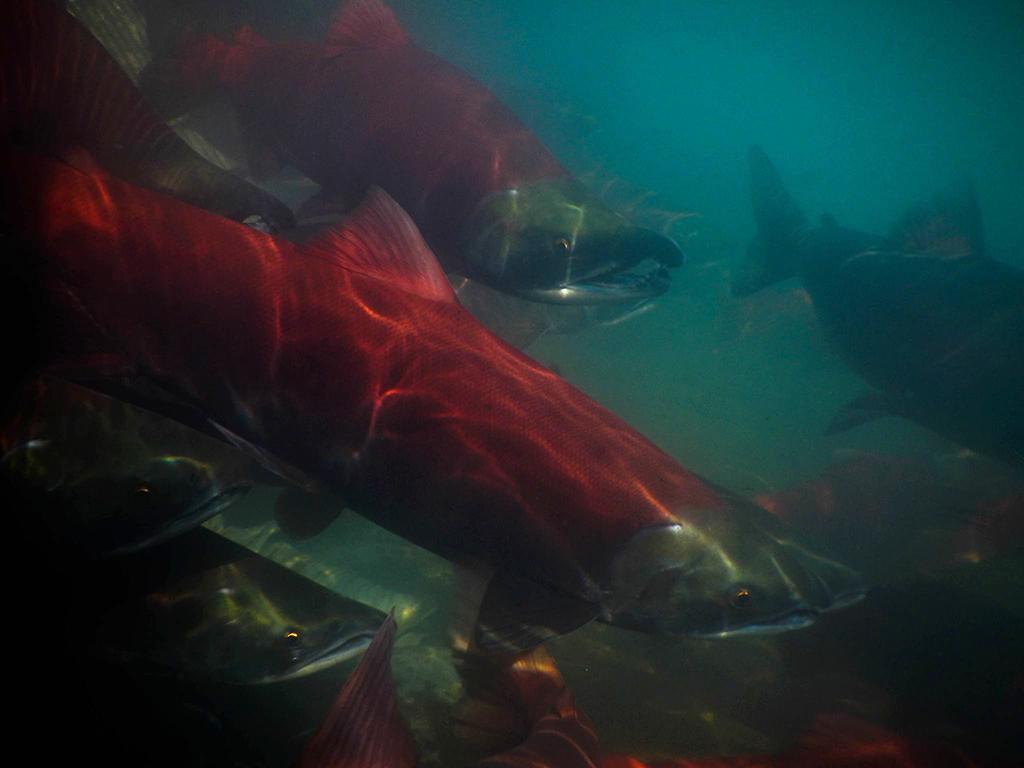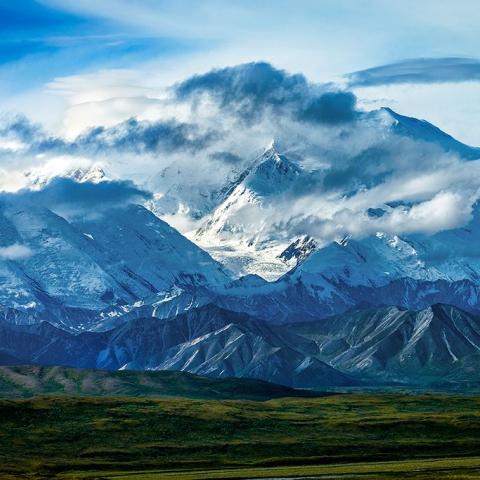Alaska is a big state (twice the size of Texas with a little room left) with 19 National Park System units, eight of which are national parks. So how about a quiz focused on these eight parks? How many of you have traveled to any or all of them, and just how much do you really know? Test your knowledge with these 10 quiz questions. You might learn something from the questions as well as the trivia.

Sockeye/red salmon, Lake Clark National Park and Preserve / NPS file
1. Lake Clark National Park and Preserve was established, in part, to protect the sockeye salmon (Oncorhynchus nerka) and their habitat. Sockeye salmon are a type of ___ fish.
a) Anadromous
b) Andromedus
c) Catadromous
d) Amphidromous

One of the Knife Creek Glaciers flowing into the Valley of Ten Thousand Smokes, Katmai National Park and Preserve / NPS - Chad Hults
2. True or False: Katmai National Park and Preserve’s landscape is composed of a group of rocks from the Peninsular Terrane.
a) True
b) False

Denali Mountain wreathed in clouds, Denali National Park and Preserve / Rebecca Latson
3. True or False: Denali Mountain in Denali National Park and Preserve, is taller than Mount Everest.
a) True
b) False

Glacier and water at Kenai Fjords National Park / NPS - Victoria Stauffenberg
4. True or False: Kenai Fjords National Park covers the largest marine area managed by the National Park Service.
a) True
b) False
5. There are over ___ named glaciers at Glacier Bay National Park and Preserve.
a) 30
b) 40
c) 50
d) 60
6. True or False: Denali National Park and Preserve is home to two reptile species.
a) True
b) False

An aerial view of a meandering river at Gates of the Arctic National Park and Preserve / NPS file
7. There are ___ wild and scenic rivers in Gates of the Arctic National Park and Preserve.
a) 3
b) 4
c) 5
d) 6

Mountains as far as the eye can see, Kobuk Valley National Park / NPS file
8. Kobuk Valley National Park is one of ___ parks located north of the Arctic Circle.
a) 2
b) 3
c) 4
d) 5

An aerial view of Malaspina Glacier, Wrangell-St. Elias National Park and Preserve / NPS - Christina Miller
9. True or False: Wrangell-St. Elias National Park and Preserve has the greatest concentration of glaciers in North America.
a) True
b) False

A Kittlitz Murrelet flying over the water at Glacier Bay National Park and Preserve / NPS file
10. True or False: Kittlitz’s Murrelets in Glacier Bay National Park and Preserve do not build nests for their eggs.
a) True
b) False
Trivia

Sockeye salmon, Lake Clark National Park and Preserve / NPS file
Let’s go back to the sockeye salmon that swim from Lake Clark National Park and Preserve into Bristol Bay, one of the last wolly wild salmon runs in the United States. In 1883, the first salmon cannery opened there and a little over 4,000 salmon were canned. Today, the Bristol Bay commercial fleet harvests around 20 million sockeye salmon valued at more than $100 million annually, making it the world's largest and most valuable commercial sockeye fishery. In 2019, 57 million fish returned to Bristol Bay, and in 2024, a preliminary count of almost 52 million sockeye have returned, making this the 10th year in a row that the total inshore run was larger than 50 million fish.

The Great Kobuk Sand Dunes, Kobuk Valley National Park / NPS file
Great Sand Dunes National Park and Preserve in Colorado may have the tallest dunes in North America, but they are not the only national park with great sand dunes. The Great Kobuk Sand Dunes in Kobuk Valley National Park are the largest active sand dunes in the Arctic. Along with the smaller Little Kobuk Sand Dunes and Hunt River Sand Dunes, the Great Kobuk Sand Dunes create 30 square miles (77.7 sq km) of towering sand 35 miles (56 km) above the Arctic Circle. 28,000 years ago, the Earth cooled and glaciers began to form high in the mountains surrounding the valley. Over time, the slow, grinding advance and retreat of the glaciers ground the rocks beneath them into a fine sand which was blown by the wind into the sheltered, ice free Kobuk Valley. When the glaciers began to retreat 14,000 years ago, they left behind 200,000 acres of rolling sand dunes along the banks of the river.

Johns Hopkins Glacier, Glacier Bay National Park and Preserve / NPS - S. Tevebaugh
A tidewater glacier, like the Johns Hopkins Glacier in Glacier Bay National Park and Preserve, is a glacier fed by enough snow to extend all the way from the mountains down to the sea. Some of these glaciers calve (break off) into the seawater. This is due to the erosive power of the warmer seawater flowing in as waves and tides to undermine the ice fronts and cause ice blocks as high as 200 feet to break off into the water, forming icebergs.
Quiz Answers
1a
Sockeye salmon are a type of anadromous fish. The salmon hatch in freshwater where they spend a couple of years, then migrate to the ocean for one to three more years before returning to the freshwater creeks, streams, and lakes of their birth to lay their eggs (spawn). This occurs near the end of their lifecycle, and shortly after spawning, the sockeye die. Click here to read more about the sockeye of Lake Clark.
2a True

Terrane map of Alaska and Katmai National Park and Preserve / NPS
Katmai’s landscape is composed of a group of rocks from the Peninsular Terrane. Just what is a terrane? A terrane is a package of rocks with a different geologic history than the other rocks around it. This package of rocks was transported to its present location via plate tectonics. The arc-shaped terranes composing Alaska are sheets of rocks which collided with other sheets of rocks, suturing themselves together at fault zones. The terrane of which Katmai National Park is composed is known as the Peninsular terrane, a part of the much larger Wrangellia composite terrane. To read more about Katmai’s geology, click here.
3a True
According to the United States Geological Survey (USGS), Denali Mountain’s base is situated on land, not at sea level. So, when measured from base to summit, Denali is actually a mile taller than Everest. Click here to read more facts about this incredible mountain.
4b False
Glacier Bay National Park and Preserve has 607, 100 acres total of marine waters, making it the largest marine area managed by the National Park Service.
5c
There are over 50 named glaciers at Glacier Bay National Park and Preserve, seven of which are active tidewater glaciers that calve icebergs into the sea. To read more about Glacier Bay’s glaciers, click here.
6b False
There are no reptile species in Denali National Park and Preserve.
7d
There are six wild and scenic rivers in Gates of the Arctic National Park and Preserve:
- Alatna River − drains the central Brooks Range
- John River − flows south from Anaktuvuk Pass through Alaska’s Brooks Range to the Koyukuk River just below Bettles/Evansville
- Kobuk River − flows from its headwaters in the Endicott Mountains and Walker Lake, through a broad valley on the southernmost reaches of the Brooks Range, passing through one of the largest continuous forested areas in the park
- Noatak River − drains the largest mountain-ringed river basin in the United States, which is still virtually unaffected by human activities (the entire Noatak River drainage of the headwaters, which are in Gates of the Arctic, is internationally recognized as a biosphere reserve in the United Nation’s “Man in the Biosphere” program)
- North Fork of the Koyukuk River – flows from the south flank on the Arctic Divide through broad, glacially carved valleys in the rugged Endicott Mountains of the central Brooks Range
- Tinayguk River − is the largest tributary of the North Fork of the Koyukuk
8a
Kobuk Valley National Park is one of two parks located north (25 miles / 40 km) of the Arctic Circle. The other park is Gates of the Arctic National Park.
9a True
Wrangell-St. Elias National Park and Preserve has the greatest concentration of glaciers in North America. Glacial ice covers 3.3 million acres (13335 sq km), or 33%, of Wrangell-St Elias.
10b False
Kittlitz’s Murrelets do build nests – on the ground - in which to lay their eggs. These nests are often found in recently de-glaciated mountainous areas. It’s another murrelete that does not build a nest, instead laying their lone egg on a stout moss-covered branch high up in a spruce or hemlock tree. To read more about Kittlitz’s Murrelets, click here.




 Support Essential Coverage of Essential Places
Support Essential Coverage of Essential Places






